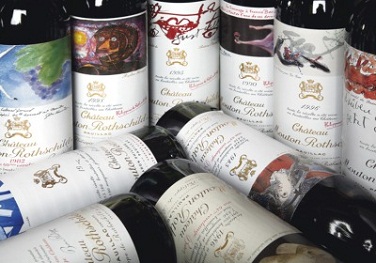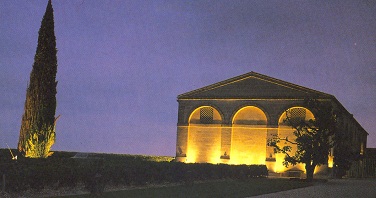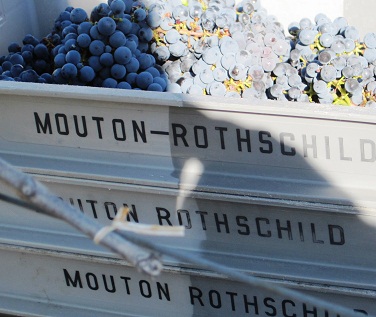Château Mouton Rothschild
1855 classification (revised 1973) - Premier Grand Cru Classé The Ségur family, who owned at one time both Lafite and Latour, and had a hand briefly in Haut Brion, also owned Mouton for two years. They sold it to Joseph de Brane in 1720 and the estate was re-christened Brane-Mouton. Unfortunately, it was an estate without a château, the buildings having been sold seperately to Dominique Armailhacq and forming the nucleus of what is today Château d'Armailhac. Under the de Brane family, Mouton steadily gathered a reputation for its wine, with prices nearly equalling the best estates of the day. The de Branes sold Mouton in 1830 and the new owners failed to keep up the previous high standards. In 1853, Brane-Mouton became Mouton-Rothschild when Nathaniel Rothschild purchased the estate, and Mouton-Rothschild started its steady rise to become one of the world's iconic wines. Not iconic enough in 1855 to be granted Premier Grand Cru Classé - a slight described by Baron Phiippe as "the monstrous injustice". It was said that the recent sale of the estate to an Englishman prevented Mouton's recognition among the elite, the truth is probably more complicated. However, the "monstrous injustice" was corrected in 1973 with a unprecedented revision of the 1855 classification raising Château Mouton Rothschild to First Growth status. The Rothschild era at Mouton has seen continuous improvement. Astoundingly, it took until the latter half of the 19th Century for anyone to build an actual château at Mouton-Rothschild when Baron James built the Petit Mouton. An iconic estate deserves an iconic character, and he arrived in 1922 when Baron Philippe de Rothschild toopk over, assuming full ownership in 1947 when he bought out his brothers. A new chais was built and all of the wines were estate bottled, something not common at the time. Baron Philippe bought the neighbouring Château Mouton-Armailhacq in 1933, renaming it Château Mouton Baron Philippe (now Château d'Armailhac). From younger vines of his two estates, Baron Philippe created the popular Bordeaux brand Mouton Cadet. To celebrate the end of WWII, during which time Baron Philippe had had to escape from Vichy imprisonment to join the Free French forces in England, and the German military had taken over Château Mouton Rothschild, the 1945 vintage was bottled with a "V for Victory" label. Thereafter, a new label was designed every year by a contemporary artist, the labels becoming every bit as collectable as the wine. The vineyards sit on a raised mound known as a "motte", from which it is presumed the name Mouton derives. Mouton-Rothschild sits immediately to the south of Lafite. For red wines the 75ha of vineyards are planted to 77% Cabernet Sauvignon, 11% Merlot and 10% Cabernet Franc with a little Petit Verdot. Wines are fermented in barrique and aged for 22 months before bottling. A second wine was introduced in 1993 - Le Petit Mouton with old-fashioned looking label that was designed by Jean Carlu who had designed the Mouton-Rothschild label in use before the War. A small amount of white wine - Aile d'Argent - is produced from mostly Sauvignon Blanc.


